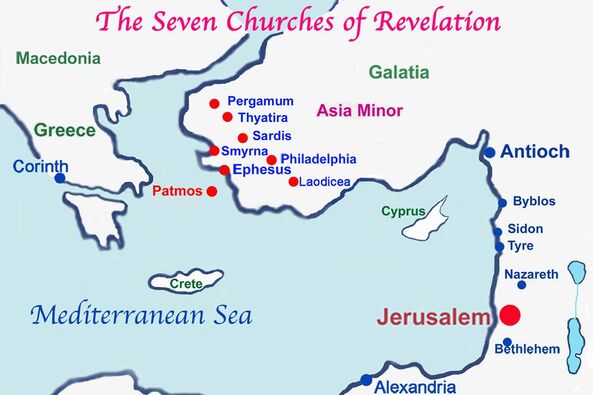Revelation 2:1-17
Lesson 471
Read both the "King James Bible" and the "New Living Translation."
In this lesson:
Chapter one was about things that have been.
Chapters two and three are about things that are.
Chapters 4-22 are about things that will be.
Ephesus, the loveless church (2:1-7).
Smyrna, the oppressed church (2:8-11).
Pergamos, the indulgent church (2:12-17).
Look for Jesus' praise, rebuke, and warning for each church.
Who were the Nicolaitanes?
This entire passage is Jesus speaking.
Chapter one was about things that have been.
Chapters two and three are about things that are.
Chapters 4-22 are about things that will be.
Ephesus, the loveless church (2:1-7).
Smyrna, the oppressed church (2:8-11).
Pergamos, the indulgent church (2:12-17).
Look for Jesus' praise, rebuke, and warning for each church.
Who were the Nicolaitanes?
This entire passage is Jesus speaking.
Where was -
Ephesus
Ephesus was a vital maritime city as well as a political, educational, and business center located on the Aegean Sea about 100 miles west of Laodicea. It was the capital of the Roman province of Asia (part of modern-day Turkey). Ephesus was one of the five most important cities in the Roman empire, and Romans called it "the first and greatest metropolis of Asia." The city was famous for its great theater and the temple to the pagan goddess Artemis (one of the seven wonders of the ancient world). Craftsmen in Ephesus became wealthy selling shrines and trinkets honoring the goddess Diana (Acts 19:24-26). With a population of 250,000, Ephesus lay on the prosperous trade route from Rome to points east and was governed by a council of one hundred aristocrats. Trade goods from all corners of the Roman Empire passed through Ephesus, making the city wealthy. Wide, well-kept streets, large public buildings, and lavish homes were everywhere.
Paul visited Ephesus in AD 53 on his second missionary journey and established the church there (Acts 19:1-41). A majority of Christian converts in Ephesus were pagan Gentiles. Still, the city became the center of Christian life after the destruction of Jerusalem in AD 70. Thanks to Ephesus' central location, the Gospel spread quickly throughout the Roman empire. Without bustling trade centers with connections throughout the empire, Christianity would have taken longer to spread. Over the centuries, Ephesus gradually lost its harbor to the accumulation of silt and sediment. Today, the ruins of Ephesus are miles from the Mediterranean Sea. The Austrian Archaeological Institute discovered and excavated the remains of the Artemis temple in the early 20th century.
Paul wrote "The Epistle of Paul the Apostle to the Ephesians" while in prison in Rome (circa AD 60-62). In Revelations 2:1-7, Jesus dictates a letter to John addressed to the Ephesus church. The Apostle John wrote his Gospel, three Epistles, and Revelation in Ephesus. John spent his final years and died there. In this passage, we see that the church in Ephesus had lost its passion for Jesus.
Smyrna
A port city on the Aegean Sea forty miles north of Ephesus at the mouth of the Meles River. Smyrna was founded by Greece but destroyed by the Lydians in 627 BC. The city was little more than an outpost with a small population for the next three hundred years. In the fourth century BC, Smyrna reestablished itself and became one of the major cities in Asia. In Jesus' day, Smyrna was a prosperous trade center. The city was well-known for its science and medicine and was called the "port of Asia." Smyrna boosted many temples, a public library, sports stadium, and one of the largest theaters of its time. The ruins of the stadium and theater can still be seen today. The Greek poet Homer (author of the Iliad and the Odyssey) was born in Smyrna, and Polycarp, a student of John's and the first Christian bishop, was martyred here in AD 155 for refusing to worship the Roman emperor. In John's day, the city had a large Jewish population that opposed Christianity. Indeed, Revelation 2:8-11 tells us that the church in Smyrna suffered horrendous persecution. Smyrna still exists today as Izmir. It is one of the largest cities in Turkey, with a population of over four million. In this segment, Smyrna is the persecuted church.
Pergamos
Pergamos (also called Pergamum) was the Roman capital of Mysia in northwestern Asia Minor (modern-day Turkey). It was twenty miles east of the Mediterranean Sea and sixty miles north of Smyrna on the banks of the river Caicus. Pergamos was built on a hill 1,000 feet above the surrounding area and was infamous for its iniquity. Many of its citizens worshipped the Roman emperor, and Pergamos erected temples to Caesar, Zeus (God of sky and thunder), Athena (goddess of wisdom), Asclepios (god of healing), Dionysius (god of wine), and other pagan gods. Little wonder Pergamos was called "Satan's throne." Many of these temple ruins can still be seen today. The sick and diseased traveled to Pergamos from all over the Roman empire to worship Asclepios and pray for good health. The Roman governor of Asia lived in Pergamos and was given the authority to execute anyone on a whim. The city was more culturally Greek than Roman, prized education, and had a well-stocked public library. Writing parchment was first made here. The Bible only mentions Pergamos in this passage, where we see them tolerating false teachers in their church. Pergamos, the lenient church.
Ephesus
Ephesus was a vital maritime city as well as a political, educational, and business center located on the Aegean Sea about 100 miles west of Laodicea. It was the capital of the Roman province of Asia (part of modern-day Turkey). Ephesus was one of the five most important cities in the Roman empire, and Romans called it "the first and greatest metropolis of Asia." The city was famous for its great theater and the temple to the pagan goddess Artemis (one of the seven wonders of the ancient world). Craftsmen in Ephesus became wealthy selling shrines and trinkets honoring the goddess Diana (Acts 19:24-26). With a population of 250,000, Ephesus lay on the prosperous trade route from Rome to points east and was governed by a council of one hundred aristocrats. Trade goods from all corners of the Roman Empire passed through Ephesus, making the city wealthy. Wide, well-kept streets, large public buildings, and lavish homes were everywhere.
Paul visited Ephesus in AD 53 on his second missionary journey and established the church there (Acts 19:1-41). A majority of Christian converts in Ephesus were pagan Gentiles. Still, the city became the center of Christian life after the destruction of Jerusalem in AD 70. Thanks to Ephesus' central location, the Gospel spread quickly throughout the Roman empire. Without bustling trade centers with connections throughout the empire, Christianity would have taken longer to spread. Over the centuries, Ephesus gradually lost its harbor to the accumulation of silt and sediment. Today, the ruins of Ephesus are miles from the Mediterranean Sea. The Austrian Archaeological Institute discovered and excavated the remains of the Artemis temple in the early 20th century.
Paul wrote "The Epistle of Paul the Apostle to the Ephesians" while in prison in Rome (circa AD 60-62). In Revelations 2:1-7, Jesus dictates a letter to John addressed to the Ephesus church. The Apostle John wrote his Gospel, three Epistles, and Revelation in Ephesus. John spent his final years and died there. In this passage, we see that the church in Ephesus had lost its passion for Jesus.
Smyrna
A port city on the Aegean Sea forty miles north of Ephesus at the mouth of the Meles River. Smyrna was founded by Greece but destroyed by the Lydians in 627 BC. The city was little more than an outpost with a small population for the next three hundred years. In the fourth century BC, Smyrna reestablished itself and became one of the major cities in Asia. In Jesus' day, Smyrna was a prosperous trade center. The city was well-known for its science and medicine and was called the "port of Asia." Smyrna boosted many temples, a public library, sports stadium, and one of the largest theaters of its time. The ruins of the stadium and theater can still be seen today. The Greek poet Homer (author of the Iliad and the Odyssey) was born in Smyrna, and Polycarp, a student of John's and the first Christian bishop, was martyred here in AD 155 for refusing to worship the Roman emperor. In John's day, the city had a large Jewish population that opposed Christianity. Indeed, Revelation 2:8-11 tells us that the church in Smyrna suffered horrendous persecution. Smyrna still exists today as Izmir. It is one of the largest cities in Turkey, with a population of over four million. In this segment, Smyrna is the persecuted church.
Pergamos
Pergamos (also called Pergamum) was the Roman capital of Mysia in northwestern Asia Minor (modern-day Turkey). It was twenty miles east of the Mediterranean Sea and sixty miles north of Smyrna on the banks of the river Caicus. Pergamos was built on a hill 1,000 feet above the surrounding area and was infamous for its iniquity. Many of its citizens worshipped the Roman emperor, and Pergamos erected temples to Caesar, Zeus (God of sky and thunder), Athena (goddess of wisdom), Asclepios (god of healing), Dionysius (god of wine), and other pagan gods. Little wonder Pergamos was called "Satan's throne." Many of these temple ruins can still be seen today. The sick and diseased traveled to Pergamos from all over the Roman empire to worship Asclepios and pray for good health. The Roman governor of Asia lived in Pergamos and was given the authority to execute anyone on a whim. The city was more culturally Greek than Roman, prized education, and had a well-stocked public library. Writing parchment was first made here. The Bible only mentions Pergamos in this passage, where we see them tolerating false teachers in their church. Pergamos, the lenient church.
Study Tip:
As you read, make two lists -
1) Things you should do.
2) Things God promises to do.
As you read, make two lists -
1) Things you should do.
2) Things God promises to do.












